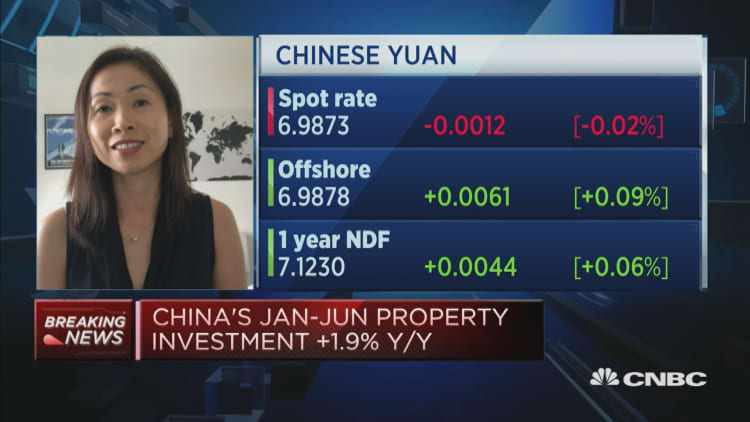BEIJING — When it comes to betting on a post-coronavirus China, some of the country's largest property developers are concentrating on a few industry and demographic trends they expect will grow in the longer term.
The coronavirus pandemic and government efforts to control it with restrictions on social gatherings has hit economic growth worldwide and increased uncertainty for property markets, particularly commercial office space. China's property market already faced challenges of debt-fueled speculation and overcapacity heading into the coronavirus outbreak. The economic shock of the pandemic on the industry is still tangible.
The vacancy rate for Grade A office space in the capital city of Beijing was 14% in the second quarter, up from 11.3% the prior quarter, according to JLL.

National sales of office buildings for the first half of the year fell 28%, according to data from the National Bureau of Statistics issued through Wind. That's slightly better than the 35.3% decline recorded for the first five months of the year, but still near historic lows.
First half data indicates China still relies heavily on investment in property development, said Bruce Pang, head of macro and strategy research at China Renaissance. He pointed out that property was the only one of three major categories of fixed asset investment that posted growth in the first half of the year.
As the commercial property market, in particular, looks for new channels of growth in coming years, some industry experts point to the following three trends:
Tech firms' demand
First, China's burgeoning technology giants are expanding. Social distancing measures and increased working from home are accelerating demand for e-commerce, as well as online games.
There's a clear level of activity in this new market opportunity, Daniel Yao, head of research at JLL China, said in a phone interview. That's according to a CNBC translation of his Mandarin-language remarks.
Morgan Stanley analysts highlighted Chinese internet companies as one of a few categories of businesses set to benefit from future growth trends and a shifting relationship among the U.S., China and Europe.
Asian internet companies are a "'Regional Champion' because of high revenues/profits generated from domestic markets with relatively limited overseas exposure," analysts wrote in a wide-ranging June 23 report called "Investing for a Multipolar World."
"China Internet companies further benefit from protected competition from global internet giants," the report added. "As the industrial internet emerges as a key growth driver for the industry, China Internet companies will also benefit given the government's support of domestic technologies."
An expanding finance industry
In the last two years, China has rapidly relaxed restrictions on foreign ownership of financial institutions in the country. Regardless of the coronavirus or trade tensions, the firms are looking to build out their presence in the world's second-largest economy.
"These trends have obvious implications for the level and nature of occupier demand," Savills researchers said in a June report on the China office market.
"International Grade A offices are likely to benefit from leading financial, IT/tech and healthcare/pharmaceutical firms as they are usually based in high spec buildings in more decentralised locations, campuses or business parks," the report said. "Grade B offices, which might have a higher percentage of (small and medium-sized enterprise) tenants, might struggle in the short term."
Culture and tourism
Third, others point to further interest in a category known as "cultural tourism" in China that typically combines a historic or scenic element with hotels or even longer-term residences.
At least half of the top 100 real estate companies in China have established a culture and tourism investment or development subsidiary, according to Qin Gang, founder of YaSong (Ode & Song) City Strategy.
The negative impact of the virus on China's real estate market makes developers more aware of the overcapacity in the traditional property market, Qin said. He added that especially as economic growth slows in China, businesses will have less demand for space in office towers, which is prompting more developers to put more capital and resources into projects tied to culture, tourism and health care.
In the first half of this year, deals and construction of domestic cultural, tourism and health care projects received more than 111.5 billion yuan ($15.9 billion) in investment, according to a report from the state-backed China Industrial Economic Information Network. Most of the deals were real estate projects in the culture tourism category, the report said.
However, the coronavirus certainly requires developers to think differently about tourism-related projects going forward.
Some new trends may include more customization and smaller groups, which might help reduce overconstruction, Lin Shaozhou, head of real estate firm Howto agency and former head of Vanke in Shanghai and Beijing, said in an online forum on July 3.


